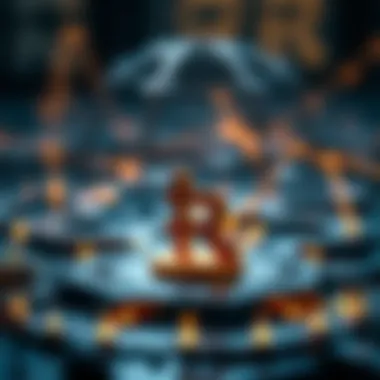Creating Non-Fungible Tokens: A Complete Guide


Intro
In today's digital landscape, the concept of owning unique assets has taken on a new level of significance, thanks to non-fungible tokens, or NFTs. These tokens allow for the representation of ownership of a specific item, whether that's digital art, music, or even video game items, on a blockchain. As these digital assets gain traction, understanding how to create your very own NFT becomes crucial for both creative individuals and savvy investors.
Creating NFTs isn't just for tech gurus; anyone with a creative spirit can dive in. This guide aims to break down the process of creating non-fungible tokens from the ground up. From understanding the lingo surrounding blockchain and NFTs to the various platforms available for minting, we'll cover it all. By the end of this piece, you'll have the knowledge you need, ensuring you can navigate the often murky waters of the NFT marketplace with confidence.
Whether your goal is to put your artwork on the blockchain or delve into the world of trading digital assets, grasping the foundational steps can set you on the right path. So, let's embark on this journey to demystify the world of NFTs.
Understanding Non-Fungible Tokens
In a digital landscape overflowing with innovation, non-fungible tokens (NFTs) have managed to carve out a compelling niche for themselves. They represent a paradigm shift in how we perceive ownership and value, particularly in the realm of digital content. Understanding NFTs goes beyond mere comprehension of what they are; it includes grasping their implications, advantages, and potential risks.
Why should one care about NFTs? Well, for starters, they offer an avenue for emerging creatives and established artists alike to directly monetize their work. While conventional art sales may involve intermediaries like galleries, NFTs afford creators a direct path to their audience, ensuring a greater slice of the pie—but it doesn't come without a few complexities. Moreover, the concept of digital ownership opens up avenues for artists to have ongoing revenue through built-in royalties in smart contracts, a feature we'll dive into later.
NFTs exemplify a significant evolution in the digital economy, resembling a game-changer. Yet, they are not without their share of legal quandaries and market-speculative pitfalls. For anyone keen on exploring this dynamic landscape, understanding the intricacies of NFTs is not just beneficial—it's essential. Let’s unpack these layers and see what’s in store.
Defining NFTs
Non-fungible tokens, or NFTs, are unique digital assets verified using blockchain technology. Unlike traditional currencies or cryptocurrencies like Bitcoin, which can be exchanged on a one-for-one basis, NFTs cannot be exchanged this way due to their distinct characteristics. Each NFT contains unique information or attributes that set it apart, making them irreplaceable pieces of digital property.
In practice, this means that an NFT might represent anything from a piece of digital art to virtual real estate in an online game. The uniqueness contributes to their value, much like owning an original painting versus a simple print. Whether you're looking at a GIF, a song, or a tweet, if it’s on the blockchain as an NFT, it’s catalogued as a unique item that adds to the expansive database of digital provenance. This unique nature drives both their allure and market volatility.
The Technology Behind NFTs
For those venturing into the world of NFTs, understanding the underlying technology is crucial. This section breaks down the key elements that do not just breathe life into these tokens but also secure their future in the digital marketplace.
Blockchain Fundamentals
At the heart of every NFT is blockchain technology, which serves as the backbone that records transactions securely and transparently. A blockchain is essentially a distributed ledger that maintains a record of all transactions across a network of computers. This feature ensures that once an NFT is minted, its provenance and ownership history are accessible and immutable.
The most notable aspect of blockchain for NFTs is its security. Since the ledger is decentralized, the risk of tampering is negligible, making it an attractive choice for artists and collectors alike. Additionally, reputable blockchains—like Ethereum—bring along robust development communities, ensuring ongoing updates and support. However, it’s worth noting that transaction fees can vary greatly, potentially impacting the costs associated with creating and trading NFTs.
Smart Contracts Explained
Next up, we have smart contracts, which play a pivotal role in the functionality of NFTs. These self-executing contracts with the terms of the agreement directly written into the code allow for automated transactions without the need for intermediaries. This technology not only facilitates the sale of an NFT but can also embed royalties for creators into the token—meaning artists can earn a percentage each time their work is resold.
What makes smart contracts particularly advantageous is their trustlessness; once deployed on the blockchain, they operate on predetermined conditions. However, the complexity of smart contract code can also come with pitfalls. If not properly coded, they might fail to execute as intended, leaving creators undeservedly disadvantaged. Therefore, attention to detail is paramount, especially for those unfamiliar with programming.
Comparative Analysis: Fungible vs. Non-Fungible Tokens
Understanding the difference between fungible and non-fungible tokens is crucial. While fungible tokens like Ethereum or Bitcoin are interchangeable—much like cash—non-fungible tokens possess characteristics that make them unique and irreplaceable.
The primary advantage of NFTs lies in their ability to deliver digital scarcity and ownership, which is decidedly absent in fungible assets. However, this uniqueness can also lead to volatility in value. The speculative nature of the NFT market means potential buyers face a minefield of price fluctuations, hinging on factors like popularity, collector interest, and market trends. Hence, anyone looking to participate in NFT trading should do so with a thorough understanding of both types of tokens and their respective markets.
"NFTs redefine how we value digital assets, but with great power comes great responsibility. Grasp the landscape before diving in."
With this foundational knowledge, you are now well-prepared to explore further into the mechanisms of creating your unique digital asset.
Choosing the Right Blockchain
When it comes to creating non-fungible tokens (NFTs), choosing the right blockchain is akin to finding the perfect foundation for a house. It doesn't matter how beautiful the house is if the foundation is shaky. Each blockchain offers unique characteristics that serve different purposes, which directly impacts the effectiveness of NFTs. From transaction fees to speed, each factor can affect both the creators and the collectors. Taking time to understand these differences is critical to ensuring a smooth minting process and fulfilling your goals in the NFT space.
Popular Blockchains for NFTs
Ethereum Overview
Ethereum stands as the pioneer in NFT development, giving rise to a vibrant ecosystem of creators and collectors. The unique aspect of Ethereum is its robust smart contract functionality. This adaptability has made it a go-to choice, allowing for complex NFT features, such as royalties and resale rights. One major characteristic of Ethereum is its large and active community, which provides support and resources for new entrants. However, the trade-off here is the higher transaction fees, especially during peak network times. If you’re aiming for wide exposure and can manage costs, Ethereum might just be your best bet.
Binance Smart Chain
Next on the list is Binance Smart Chain, or BSC for short. It offers a notable advantage in terms of lower transaction fees compared to Ethereum. This blockchain is fast, making it an appealing option if you're looking to mint NFTs efficiently without breaking the bank. The key characteristic of BSC, however, is that it benefits from the larger Binance ecosystem, which opens doors to potential market exposure. One downside is that BSC is newer, which might mean less established protocols or community resources compared to Ethereum. So, if you're looking for speed without the high costs, BSC might be worth considering.
Polygon and Layer Solutions
Polygon has emerged as a formidable player in the NFT landscape. It offers a layer 2 solution that bolsters Ethereum’s capabilities by drastically reducing transaction fees and speeding up processing times. Essentially, it improves Ethereum’s scalability while maintaining security. A key benefit of using Polygon is its compatibility with Ethereum assets, giving creators a wider net to cast when it comes to audience and market integration. However, while Polygon reduces friction in transactions, it's important to note that it might have lower visibility compared to Ethereum-based NFTs. If you're keen on creating but wary of excessive fees, Polygon could be the sweet spot for you.
Factors Influencing Blockchain Selection
Transaction Fees
Transaction fees often serve as a painful point for creators diving into the NFT waters. Understanding how transaction fees operate can greatly influence your choice of blockchain. Fee structures can vary enormously, with Ethereum being known for its sometimes exorbitant costs during busy periods. Choosing a blockchain with reasonable transaction fees means you can maximize profits and sustain your creative endeavors.
Network Scalability


When you create an NFT, you don’t want to find out that the network can’t handle the demand. Network scalability refers to the blockchain’s ability to manage increased activity without significant performance drops. Ethereum is often criticized for congestion issues, while an adaptive option like Polygon shines here. When selecting your blockchain, make sure scalability aligns with your plans to launch and promote your NFTs, so you won’t face bottlenecks.
Community Support and Development
Last but not least, the community surrounding a blockchain can make all the difference in your minting journey. An active, engaged community not only offers troubleshooting support but also helps in fostering innovation. Established blockchains like Ethereum and Binance Smart Chain have rich communities that contribute to ongoing development and usability advancements. On the other hand, newer platforms may lack the extensive resources you might need. Opting for a blockchain with a strong community can ease the process and inspire confidence in your projects.
Platforms for Minting NFTs
Choosing the right platform for minting non-fungible tokens can have a significant impact on an artist's success, as well as the functionality of the token itself. Each platform offers unique features and capabilities that can cater to different needs. In this section, we’ll explore various NFT marketplaces and the differing approaches to self-minting, each with its benefits and potential drawbacks.
Overview of NFT Marketplaces
NFT marketplaces serve as the digital open-air shops of the blockchain world, bringing artists and collectors together. These platforms allow users to create, buy, and sell NFTs in a streamlined manner. Among the various options available, three noteworthy marketplaces are OpenSea, Rarible, and Mintable.
OpenSea
A titan in the NFT marketplace realm, OpenSea has positioned itself as a go-to platform for many creators, providing an incredibly diverse and expansive ecosystem. One notable aspect is its user-friendly interface that can attract both novices and seasoned artist alike. Users can easily list their creations without any coding experience, which can be a huge advantage.
One unique feature of OpenSea is the ability to create bundles, letting users list multiple NFTs together for a single price. While this can increase convenience for buyers, it’s something that can only be fully appreciated if the user is familiar with the scope of their offerings and how to craft compelling bundles. A drawback to consider is the high fees tied to transactions, which can influence profit margins, particularly for up-and-coming artists.
Rarible
Another player making waves in the NFT market is Rarible. It empowers creators with more control over their creations. One key characteristic is the community governance model that enables users to vote on platform changes, giving it a sense of ownership not commonly found in other marketplaces. This community-centric approach can attract those who value inclusivity and personalization in decision-making.
What makes Rarible stand out is its minting of NFTs with the option of defining royalties, a feature that benefits artists by allowing them to gain a percentage from future sales of their work. However, with these conveniences come associated costs, and the users must keep in mind that transaction fees can fluctuate based on demand.
Mintable
Mintable has staked its claim by making the NFT minting process more accessible through laymen’s terms. It provides a straightforward approach, which can be particularly attractive for those who might feel daunted by more complex platforms. One of its key selling points is the ability to create and sell NFTs free of charge, though this might come with limitations that some professional artists may find restrictive.
An interesting feature of Mintable is its ability to offer gasless minting, which means creators can launch their works without incurring hefty blockchain fees up front. This can be appealing, especially for artists just starting out. However, aspirational creators should be aware that this method ties the asset to a unique platform's features, possibly limiting exposure to wider markets.
Self-Minting vs. Marketplace Minting
Minting refers to the process of creating an NFT, which can be executed via self-minting or through a marketplace. This choice hinges on individual preferences and goals.
Pros and Cons of Each Method
When weighing the pros and cons of self-minting versus marketplace minting, it's vital to understand the key contrasts:
- Self-Minting: This approach offers greater control over the process but may require technical proficiency and a deeper understanding of blockchain mechanics. It can also potentially lead to savings in fees.
- Marketplace Minting: This is generally easier and more accessible for those less familiar with NFTs. However, a fee structure typically applies, and the level of control over assets may decrease.
Considerations for Artists and Creators
For artists contemplating which method to employ, several considerations come into play:
- Target Audience: Artists should think about where their audience is more likely to engage. Some may prefer popular marketplaces, while others might seek unique and lesser-known platforms.
- Brand Identity: How the artist wants to represent themselves can influence the decision, especially in regard to royalties and copyrights.
- Long-Term Goals: Understanding the implications on future sales can determine whether one should opt for self-minting or use a marketplace.
"Navigating the NFT space is like finding your footing in a vast ocean; understanding the currents can help you sail rather than sink."
Ultimately, artists must choose what aligns best with their values and objectives in this evolving digital landscape. The landscape continues to shift, and as such, informed decision-making will remain paramount.
Creating Your Digital Asset
Creating a digital asset is the linchpin of the NFT process. This stage is where your imagination meets technology, effectively transforming your ideas into something tangible and valuable in the digital world. You'll want to consider various aspects, including the type of content you wish to create and best practices for ensuring your asset stands out in a crowded market. The digital landscape is vast, and having a strategy for your asset can spell the difference between success and being lost in the shuffle.
Types of Digital Content
Artwork and Collectibles
Artwork and collectibles have carved out a significant niche within the NFT sphere, captivating enthusiasts with their aesthetic allure and often sentimental value. The unique feature of this type of digital content lies in its ability to evoke emotions and convey personal narratives. Artists have the power to express themselves uniquely, each piece carrying an individualized story embedded in it. Thus, artwork represents a beneficial choice not just for creators but also for collectors who seek items that resonate with their personal tastes.
However, it’s worth noting that while the artistic nature can drive interest, it also involves intense competition. To carve your place, you'll want an angle that sets your work apart; originality is key, but quality also plays a paramount role.
Music and Audio Files
When it comes to music and audio files, NFTs offer a fresh avenue for musicians to monetize their work, something many have sought for years. One prominent characteristic of this type of asset is its ability to forge a deeper connection between musicians and fans. By offering exclusive content, such as behind-the-scenes access or limited-edition tracks, artists can enhance their engagement and encourage loyalty.
The potential of earning royalties every time the NFT is sold in the secondary market stands out as a significant advantage. However, there's a flip side: the less tangible nature of audio compared to visual art may lead to challenges in establishing value. What’s more, competition exists not just among musicians, but with traditional music distribution platforms, which can dilute attention.
Virtual Real Estate
Virtual real estate has emerged as a fascinating frontier within the NFT ecosystem, as individuals and companies alike begin to recognize the value of digital spaces. It reflects a blend of creativity and investment opportunity, with virtual properties appearing in metaverses like Decentraland and The Sandbox. One of the most compelling aspects is the ability to develop these spaces—be it through constructing galleries, hosting events, or creating interactive experiences.
Certainly, this can be a lucrative choice, given that land in desirable virtual locations can appreciate significantly over time. Still, it’s essential to be mindful of the risks involved, such as market volatility and the need for continuous engagement to ensure your investment yields returns.


Best Practices for Asset Creation
Quality and Resolution
Quality and resolution are not mere technicalities; they are foundational to the success of any digital asset. High-resolution images or audio files directly influence the perceived value and quality of the NFT. A crisp image or a flawless audio track can create a more immersive experience for potential buyers. As the market becomes increasingly demanding, the importance of delivering top-notch content cannot be understated.
While high quality may incur larger file sizes, which can affect loading times and user experience, the positive impression that a well-crafted asset leaves will generally outweigh potential drawbacks. Remember that creating a superior asset is akin to laying a solid foundation; everything built upon it has a greater chance to thrive.
File Formats
Choosing the correct file formats for your digital asset is crucial to ensure compatibility and quality. Many platforms support a variety of formats, including JPG for images, MP3 for audio, and even GIF for animated pieces. Selecting the right format has a direct impact on the quality, viewer experience, and functionality of your NFT. For example, GIFs can provide a dynamic element, engaging viewers through motion; however, they often sacrifice some detail for that dynamism.
Some formats may also have limitations regarding platform compatibility, which could lead to frustrating experiences. It’s wise to familiarize yourself with supported formats where you intend to mint your NFT and select accordingly.
Licensing Considerations
Licensing considerations are often overlooked but can have significant implications in the world of NFTs. Knowing how to handle copyright laws and understanding what rights you are transferring when minting an NFT is vital. The essence of licensing is about defining what the buyer can and cannot do with your asset. This can comprise various rights, such as reproduction, public display, or the ability to create derivative works.
Well-defined licensing can help you retain certain rights even after the sale, ensuring that you can continue to be recognized for your work. However, ambiguity in your licensing terms can lead to disputes or even loss of control over the asset. It’s critical to be both clear and comprehensive in laying out these terms to safeguard your interests as a creator.
Minting Process Explained
Minting is a central aspect of creating non-fungible tokens (NFTs). It’s the act of converting a digital asset into a token on the blockchain. This process lays the groundwork for ownership and transfers, ensuring that each NFT has its unique provenance. Understanding the minting process is crucial for artists, creators, and investors alike as it influences how digital assets are perceived and valued in the NFT market.
The minting process is not just a technical operation; it encompasses various steps that require attention to detail. It can define one’s entry into the dynamic world of NFTs and can dictate the success of a digital asset in a saturated marketplace. Each element of this process contributes towards making NFTs authentic, tradable, and collectible.
Step-by-Step Minting Procedure
Connecting to a Wallet
Connecting to a digital wallet is the first essential step in the minting journey. A digital wallet holds cryptocurrencies and can also store NFTs once they are minted. This wallet acts as your online bank account in the blockchain world, safeguarding your assets.
A key characteristic of connecting to a wallet is the variety of options available. Popular choices include MetaMask, Trust Wallet, and Coinbase Wallet, each boasting different features and levels of security. By connecting to a wallet, users can seamlessly interact with various NFT platforms, enabling them to upload and manage their digital assets efficiently.
One unique feature of wallets like MetaMask is its browser extension capability, allowing users to access decentralized applications directly. However, this can also add complexity for newcomers who may find navigating these technologies a bit trickier. Therefore, picking the right wallet is not just about security but also about ease of use.
Uploading the Asset
After establishing the connection to a wallet, the next step is uploading the digital asset that one wishes to turn into an NFT. This aspect is vital since the quality and nature of the asset can directly impact its desirability and value in the marketplace.
The process of uploading is straightforward on most platforms and requires users to select their digital file, whether it's a piece of art, a video, or music. What stands out here is the importance of file formats; many platforms have specific requirements, and using the right format can save a lot of headaches later.
A considerable advantage of this step is the immediate visibility it provides to your creation. Once uploaded, individuals can promote their NFTs on various platforms, yet there are pitfalls too. If the asset does not meet quality standards or the platform's guidelines, it can be rejected or poorly received, impacting one’s reputation.
Setting Royalties and Metadata
Setting royalties and metadata is a crucial part of the minting process that many overlooked. This step allows creators to earn ongoing revenue whenever their NFT is resold in the marketplace. The potential for artist autonomy in determining royalty percentages can significantly benefit their earnings over time.
The importance of metadata lies in the information it provides about the NFT, such as its title, description, and the creator's name. Good metadata can enhance the asset's discoverability, making it more attractive to potential buyers. What’s appealing about this process is that it not only establishes ownership but also builds a narrative around the asset that can resonate with collectors.
However, there is a downside. Setting unrealistic royalties might scare off potential buyers, especially if they perceive them as excessively high. Balancing these elements is critical and requires thoughtful consideration.
Post-Minting Considerations
Transaction Confirmation
Once the minting is complete, transaction confirmation is the next logical step. This refers to the process by which the blockchain verifies that the minting transaction has been successfully executed. This step can take some time depending on network load, but it is pivotal.
A key characteristic of transaction confirmation is its role in establishing trust. When a transaction is confirmed, it guarantees that a digital asset is officially part of the blockchain, securing the ownership and authenticity of the NFT.
One unique feature is the potential for fees associated with various blockchains; observing these is essential, as higher fees can delay the confirmation process. However, a confirmed transaction is a signal to markets and collectors that your asset is legitimate, enhancing its potential value.
Asset Visibility on Marketplaces
After transaction confirmation, the final leg of the minting route involves ensuring the asset's visibility on marketplaces. Visibility determines whether your NFT can be seen, coveted, or purchased by potential buyers.
In this digital environment, platforms such as OpenSea or Rarible serve as the online showcases for NFTs. The standout feature here is how these marketplaces can amplify one’s reach through their established networks, thus increasing chances for sales.
However, gaining visibility doesn’t guarantee sales; trends, marketing, and community engagement play vital roles too. It’s like setting up a beautiful storefront in a busy market, but without foot traffic, it won't lead to sales.
In summary, the minting process is rich with nuances that can contribute to the overarching success of an NFT venture. Each procedure—from connecting to a wallet to understanding marketplace dynamics—plays a crucial role. By navigating this journey thoughtfully, individuals can position their creative outputs for the best chances in a competitive space.
Legal Aspects and Intellectual Property
Understanding the legal landscape surrounding non-fungible tokens (NFTs) is critical for creators and investors alike. As the popularity of NFTs grows, so too does the importance of safeguarding intellectual property rights and ensuring compliance with existing laws. This section delves into the key legal aspects associated with NFTs, emphasizing copyright laws and the rights associated with these unique digital assets. With so much at stake, knowledge of these elements can prevent costly misunderstandings and foster a more sustainable NFT environment.


Copyright and NFTs
Understanding Copyright Laws
Copyright laws form the backbone of intellectual property rights, playing a vital role in the world of NFTs. These laws protect original works from unauthorized use, ensuring that artists and creators maintain ownership of their creations. In the context of NFTs, understanding copyright laws is beneficial because it helps creators to assert their rights over their digital assets while also allowing buyers to know what they're actually purchasing.
A key characteristic of copyright laws is the protection it offers automatically, as soon as the work is created and fixed in a tangible medium. This means that creators of artwork, music, or any other original content instantly gain certain rights without needing to file for copyright. However, it's important to note that transferring an NFT does not inherently transfer copyright unless explicitly stated.
The unique feature of understanding copyright laws in regards to NFTs is the complexity brought about by digital ownership. The advantages are clear for the creator, as they can legally protect their work and potentially earn royalties on secondary sales. On the flip side, potential issues can arise during transfers, as buyers might mistakenly assume they own complete rights when acquiring an NFT.
Transfer of Rights in NFTs
When it comes to the transfer of rights in NFTs, it's crucial to comprehend what rights are being conveyed when an NFT is sold. An NFT can represent ownership of a digital asset, but not necessarily its copyright or intellectual property. A significant aspect of this transfer revolves around what rights are included in the sale of the NFT and how these rights can be communicated clearly to buyers.
A notable characteristic of this transfer process is the potential for misunderstanding among buyers and sellers. This can pose challenges for creators who wish to retain certain rights while transferring others. For example, if an artist mints an NFT of their artwork but wants to keep the right to reproduce it, they must specify that in the sales agreement.
The unique advantage of grasping the concept of rights transfer is that it helps both artists and collectors establish clear expectations. This approach minimizes the chance of legal disputes down the line, therefore bolstering trust in the NFT marketplace. However, a disadvantage is that failing to clarify what rights are included can lead to buyers feeling misled after the transaction is completed.
Avoiding Legal Pitfalls
Using Original Content
Creating NFTs from original content is fundamental. This not only respects copyright laws but also enriches the NFT ecosystem with authentic creations. Leveraging original content means that artists can assert their rights and are less likely to encounter legal issues.
A key characteristic of working with original content is that it ensures the creator has full rights to what they're selling. This choice is particularly beneficial for artists, musicians, and creators looking to establish a reputation while maintaining full ownership of their work.
The unique feature of pursuing original content is the sense of authenticity it brings to the creator's portfolio. This authenticity can create a loyal following. However, one should be careful. Working without proper documentation can still open the door to disputes if someone else claims ownership.
Understanding Licensing Agreements
Licensing agreements play a crucial role in the NFT marketplace. By clearly outlining what rights are being transferred along with the NFT, these agreements help to define the relationship between the creator and the buyer. Understanding these agreements ensures that all parties are on the same page regarding ownership and permitted usage.
One significant characteristic of licensing agreements is their ability to distinguish between ownership and usage rights. This is particularly beneficial in the NFT space where buyers often assume they own full rights to an NFT. Having a clear license agreement can help prevent assumptions and set expectations for both sides.
The unique feature of solid licensing agreements is that they enable creators to specify what buyers can and can't do with their NFTs, whether it's commercial use or merely personal enjoyment. However, understanding the nuances of each agreement can be complex, resulting in challenges for those not well-versed in legal language, which could lead to future disputes.
Market Dynamics and Pricing Strategies
Navigating the realm of non-fungible tokens inevitably leads one to confront the mercurial currents of market dynamics and pricing strategies. Understanding these elements is not just beneficial; it's an absolute requisite for anyone serious about the NFT space. The market for NFTs is ever-evolving, influenced by factors that range from technological advancements to shifts in consumer behavior. Grasping these dynamics allows creators and investors to make informed decisions that can significantly affect their success.
Understanding Market Trends
Analyzing Recent Sales
When diving into the world of NFTs, having a close eye on recent sales trends is crucial. Recent sales provide a lens through which one can observe what types of digital assets are capturing interest and fetching the highest prices. A significant aspect here is tracking the performance of different categories—artwork versus collectibles, for example. This not only sheds light on current market preferences but also highlights investment opportunities.
In this fast-paced environment, the key characteristic of recent sales is their ability to reflect real-time demand. Knowing which NFTs are selling well can inform your creation process, ensuring that you align with current consumer interests. For instance, if you notice that street art NFTs are trending, consider channeling your creative energy in that direction.
Recent sales trends are the pulse of the NFT market, providing invaluable insights for creators and investors alike.
However, there exists a unique feature here that demands caution: volatility. Often, an asset might spike in popularity due to a fleeting trend, leading to an inflated market price that may not sustain itself over time. Therefore, while yes, tracking sales can be immensely beneficial, it's equally important to adopt a measured approach, blending data analysis with a dose of skepticism.
Influence of Hype and Demand
Another significant piece of the NFT puzzle is the influence of hype and demand. We live in an age where social media can make or break an NFT’s market value overnight. A viral tweet or a blog post can send prices soaring or crashing, affecting creators and collectors alike. Understanding this aspect is vital, especially if you’re contemplating entering the market.
The key characteristic here revolves around the role of community and marketing. A well-executed marketing strategy can elevate an NFT’s visibility and desirability, but the inherent risks are equally high. Misinformation can lead to disillusionment among potential buyers, creating a roller-coaster experience.
A unique feature of this phenomenon is the shorter time frame in which decisions are made—often, potential buyers will make snap judgments based on the most recent social media chatter. This can be advantageous if timed correctly, but there's also a steep learning curve for those just starting out.
Setting the Right Price
Establishing a suitable price for NFTs is a delicate balancing act that requires meticulous thought and strategy. If you're looking to stay competitive while still monetizing your creativity, understanding various pricing strategies is paramount.
Valuation Techniques
Valuation techniques are essential in determining how to price your digital assets effectively. This involves not only analyzing the intrinsic value of the asset but also considering external factors like market trends and comparable sales. It’s worth noting that there is no one-size-fits-all answer when it comes to valuation.
A key characteristic of valuation is the versatility it offers. From heuristic approaches based on previous sales to advanced financial modeling, different strategies can be applied based on the creator’s needs and market conditions. For example, using a multiplier of a similar asset that has recently sold can give you a ballpark figure for your own NFT.
The unique feature of this method is that it allows sellers to stay adaptable. If a particular style of artwork is surging in popularity, you can adjust your price accordingly, seizing the moment to capitalize on heightened demand. In contrast, failing to adapt could mean leaving money on the table or, worse, pricing your assets too high in a declining market.
Pricing Models in NFT Sales
There are various pricing models utilized in the NFT marketplace, each catering to different creators’ needs and philosophies. Auction models, fixed prices, and tiered pricing are just a few options. Each model has its own set of advantages and disadvantages, making it crucial for creators to choose wisely.
One key characteristic of auction models is their potential for driving prices upward due to competitive bidding. This can lead to situations where an asset sells for far more than its initial valuation, which can be a game-changer for both emerging and established creators.
However, reliance on auctions can be a double-edged sword. There's no guarantee of a sale, which may leave creators in limbo. Whether you prefer the certainty of fixed pricing or the unpredictability of auctions, understanding these different options is critical to your success in the NFT market.
In summary, the market dynamics and pricing strategies surrounding NFTs are intricate and multifaceted. By carefully monitoring sales trends, understanding the influence of hype, and picking the right pricing model, creators and investors can navigate this vibrant landscape effectively.















